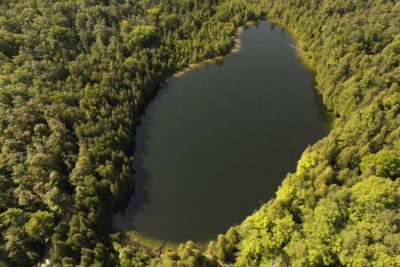Charles Darwin upset a lot of people with his 1859 publication On the Origin of Species. Like Copernicus and Galileo before him, Darwin radically revised the place of humans in the natural world. Victorian society believed that a beneficent creator made Earth and all its species in one fell swoop, installing Homo sapiens near the top of the great chain of being. Darwin showed otherwise: new life forms, including humans, come into being as generations adapt to change over millions of years, and all species share one immense family tree. Darwin was widely attacked; as his biographer Janet Browne put it, his theory outraged competitors and turned “friends into deadly foes.”
Today we are confronted with a similar rejection of scientific evidence from within the discipline that helped to prove Darwin correct: geology. Considering a proposal to name the inception of a new epoch in Earth’s history the Anthropocene, 12 of 22 members of the Subcommission of Quaternary Stratigraphy (SQS), part of the International Union of Geological Sciences (IUGS), voted “no,” thus killing the proposal. But the proceedings were marked by irregularities. The SQS had voted before outstanding recommendations made by the IUGS Geoethics Commission were implemented, and 11 of those who voted, including 10 of the “no” votes, were ineligible to do so because they had exceeded their term limits. When the chair and a vice chair of the SQS objected, they were removed from executive duties.
An expert panel had determined the parameters defining the Holocene had not only been exceeded, but in some areas smashed.
Savage academic infighting is nothing new, but this tempest has important implications for the rest of us. Geological epochs define unique intervals of Earth’s history, and they’re defined by significant changes in geological deposits, like fossils or geochemical signals. Leaving the Holocene, which represents the last 11,700 years of relatively stable climate conditions, for the human-altered Anthropocene, which geological and other scientific evidence shows we have undoubtedly done, means we’ve set the planet on an entirely new trajectory compared to anything that has come before.
The conversation about whether or not humanity has entered a new geological epoch began in 2000 when Paul Crutzen, the Nobel Prize-winning chemist, interrupted a meeting of the International Geosphere-Biosphere Programme. One after another, scientists were reporting on novel changes to the systems they studied. “Stop saying Holocene,” Crutzen groused. “We’re in the Anthropocene.” Crutzen was asserting that the parameters defining the Holocene had been breached by human activity.
Humans, like beavers, prairie dogs, earthworms, and many other species, have modified Earth for millennia. Various approaches to agriculture, for example, have reshaped ecosystems. Near the middle of the 20th century, however, something new happened. Human population, production and consumption of goods, and globalization began to increase exponentially. Historian John McNeill and chemist Will Steffen named this intensifying phase the Great Acceleration. Environmental geographer Ruth DeFries calls it the Big Ratchet.
An algal bloom, fueled by fertilizer runoff, around the Swedish island of Gotland in the Baltic Sea.
European Space Agency
With care and rigor, an expert panel of 33 scientists, called the Anthropocene Working Group (AWG), examined Crutzen’s claim. Over 14 years, the AWG [of which Barnosky, this article’s coauthor, is a member] vetted hundreds of studies and conducted additional research of its own. Along with a major swath of scientists in related fields, the AWG determined that yes, the parameters defining the Holocene had not only been significantly exceeded worldwide but in some areas smashed, and the Earth system had crossed a threshold into a new normal.
The next question for geologists defining the geologic time scale was when, exactly, the change had occurred. Major divisions in Earth’s history are marked by big changes in its geological layers. Time periods can be discerned in lake and ocean sediments, ice cores, peat bogs, and coral reefs — all of which provide conclusive evidence that the Anthropocene is real.
Beginning around 1950, the geological record changes dramatically. Around the world, geologists find fallout from nuclear bomb testing, many kinds of pollutants including “forever chemicals” and plastic particles, and novel, human-made minerals and rocks, including massive amounts of concrete. We see rearrangements in sediment depositions on land and in the oceans that result from agriculture, cities, roads, dams, and water distribution systems. Unique assemblages of plants and animals reflect massive transport of species around the globe and the replacement of wild animal bones with the remains of cattle, sheep, and other domesticated animals. The record silently asserts that for the first time in Earth’s history, a single species has become a geological force: Homo sapiens.
If we don’t name the Anthropocene, we will hamstring efforts to support a safe operating space for humans and other species.
For a new epoch to be officially designated, however, evidence for it must be globally synchronous, which means it must appear all over the Earth at the same time in the geological record. This distinction is important. Local developments don’t necessarily add up to changes in how the whole Earth system functions. Global changes at significant intensities do.
In 2023, twelve teams of scientists reporting from all over the globe presented evidence to help determine a single site where the shift from Holocene to Anthropocene could be exemplified. From the Baltic Sea to Antarctica, from the San Francisco Bay Area to a lake in China, to coral reefs in the Gulf of Mexico and the Indian Ocean – the markers were almost numbingly uniform. In the silent witness of sediments accumulated there over thousands of years, Crawford Lake in Canada so clearly illustrated this history that it was chosen by the AWG to hold the “golden spike” of the Anthropocene. As with the other sites, the lake showed lasting geological signals that markedly intensified in the 1950s.
With the recent vote, the gatekeepers of geological time have disregarded evidence of hundreds of peer-reviewed studies, claiming that the Anthropocene is a relative term that can’t be pinned down in time and space, precisely identified, or measured.
Crawford Lake in Ontario, Canada, where a golden spike would have marked the start of the Anthropocene.
Cole Burston / The Canadian Press via AP
In arguing against the Anthropocene, this small minority of scientists ignores the most central tenet of their discipline: rely on data, not belief or conviction. They assert that since humans have been shape-shifting our environment at least since the advent of agriculture, the mid-20th century and onward isn’t special enough to warrant designation as a geological epoch. They don’t acknowledge that earlier developments in human technologies did not result in globally synchronous impacts, as is evidenced in the mid-20th century. Those advancements were part of the buildup to the Anthropocene, but they did not rapidly impact the whole planet at the same time, and they did not fundamentally change Earth’s operating system, as advancements in the mid-20th century did.
Some cultural commentators have opined that whether or not geologists officially define the Anthropocene, they will continue to recognize it. Artists, writers, historians, sociologists, epidemiologists, and others don’t depend on a formal designation to confirm we are all living in an environment that’s becoming more unstable. But international scientific consensus based on voluminous evidence and analysis can help guide us in addressing our challenges. If we don’t name the Anthropocene to reflect the massive perturbations that began in the Great Acceleration and continue today, we will hamstring our efforts to support a safe operating space on Earth for humans and the myriad species we depend on. The window for taking effective action to change our dangerous trajectory is closing fast.
The past has seen vituperative resistance to paradigm-shifting discoveries that changed fundamental ideas about Earth’s history. That plate tectonics keep continents on the move and that a meteor strike caused the mass extinction of dinosaurs, for example, are concepts that were anathema to many who were powerfully attached to the worldviews they had inherited. Eventually the evidence was accepted by new generations, and these concepts have been enshrined in textbooks.
Darwin might be intrigued that, ironically, the Anthropocene in one sense restores the biblical vision of humanity’s place astride the planet. He might marvel that a small, unimpressive mammal over eons of natural selection gained enough power to transform an entire planet. Darwin may even have analyzed lake sediments to make his own Anthropocene inquiries. Seeing the evidence of a new epoch, his main questions might have been “Can humans adapt to the changes we have wrought?” and “How much time have we got?”


